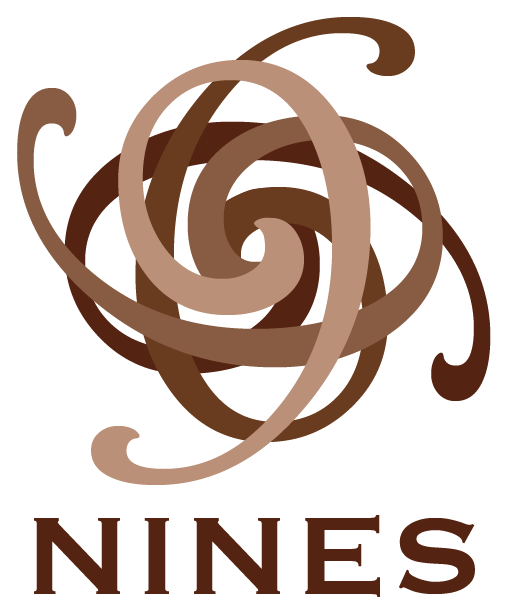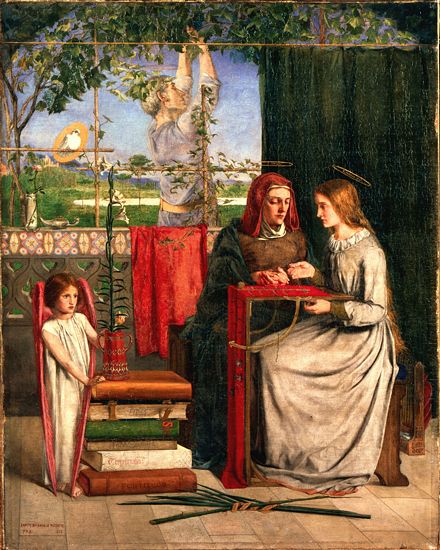2005-2007

Jerome McGann received a Mellon Lifetime Achievement Award and devoted it all to beginning NINES which he designed to accomplish to main tasks:
- To offer peer review for digital projects so that junior scholars could professionally afford to participate in the digital revolution (that is, without being denied tenure or promotion);
- To gather together and render interoperable all the major 19th-century digital resources, the Whitman, Blake, and Rossetti archives prominent among them.
He brought together an initial steering committee of Steven Jones and Neil Fraistat, directors of Romantic Circles, along with the directors of the major archives and Laura Mandell, director of the Poetess Archive.
Led by Bethany Nowviskie, we developed the NINES aggregation model. McGann and Nowviskie used Rich Description Framework (RDF) metadata to allow for simultaneous searching of all the archives without forcing them to change their own structure and/or coding in any way at all, setting the bar relatively low for joining NINES, aside from content review which was and continues to be very rigorously performed by ARC’s exceptional editorial boards.
2007-2008
The 2007-2008 academic year was a time of transition for NINES, when Jerome McGann stepped down as director and Andrew Stauffer came to UVa to take his place. Dana Wheeles (serving as interim Project Manager since the departure of Duane Gran in 2007) was formally hired as Project Manager in June.
In this period, development on Collex and Ivanhoe was frozen, while Nick Laiacona completed version 1.3 of Juxta under the direction of Jerome McGann. Included in this release was the ability to identify passages in texts that were transposed, or moved, in other witnesses, and a search bar allowing users to find the location of words or short phrases in a comparison set.
During the 2008 Summer Workshop hosted by Associate Director Laura Mandell, NINES Project Manager Dana Wheeles and Lead Developer Nick Laiacaona were able to conduct a usability study on Collex, to determine the ease with which scholars and librarians were able to navigate the resource. A redesign of the site was begun, and another formal usability study was completed in October of 2008 with the help of Erin Mayhood and University of Virginia Library.
2009
Work on the second phase of the redesigned site was coupled with a refinement and expansion of the Exhibit Builder feature in Collex (First published peer-reviewed exhibit: Federica Mazzara’s “Lettere A Colori”).
Thanks to the hard work done late in 2008, NINES gained recognition as an active scholarly institution and software developer. NINES was featured in UVa Today Magazine, and Director Andrew Stauffer was interviewed for a segment on the NPR affiliate WMRA. NINES was also presented at a series of conferences (STS, MITH, NVSA) with a focus on fostering closer connections with scholars across the Atlantic (COST-Action 32, DHO). In May, Nick Laicona, Laura Mandell and Dana Wheeles presented NINES and Juxta at a meeting of European scholars in Gothenburg, Sweden, which was not only beneficial institutionally, but also crucial to the next step in Juxta’s development.
Following the Gothenburg meeting, NINES held its first European summer workshop, hosted by the DHO in Dublin, Ireland. Andrew Stauffer and Laura Mandell were able to arrange a concurrent meeting with scholars involved in projects overseas and introduce and welcome them to the NINES model of aggregation and peer review. In addition, that meeting was instrumental in forming the NINES sister site, 18thConnect. Mandell invited the British Library and the representatives of Gale Cengage to a meeting in Dublin that laid the foundation for 18thConnect’s contract with Gale to correct the mechanically-typed text of the ECCO catalogue.
2010
For the academic year of 2010-2011, NINES expanded its graduate fellowship program to five students, offering basic training in the management and creation of digital projects. NINES also released the NINES Classroom (nines.org/classroom) to offer a place in NINES for professors and teachers to teach their students about nineteenth-century materials online and strategies for research in the digital world.
A flurry of projects were reviewed and/or aggregated in Spring of 2010, the most notable being the English Short Title Catalogue (ESTC), the first resource to be shared between NINES and the newly-released 18thConnect (beta in June, 2010). The ESTC would be the basis for constructing the necessary metadata for Gale’s ECCO, which came online later in the year. At this time, NINES also shifted its policies regarding metadata harvesting: whereas previously, all contributors were responsible for submitting metadata for their sites, NINES decided to make use of primary-source content from the Library of Congress made freely available on their site according to OAI-PMH standards. Sites like the LOC and the New York Public Library offer invaluable content that augments the scholarly resources already in NINES.
Laura Mandell and Dana Wheeles taught a second NINES/18thConnect summer workshop at the Digital Humanities Observatory in Ireland. After this time, NINES began sponsoring scholarships to the Digital Humanities Summer Institute at Victoria where it will begin offering classes (beginning summer 2014).
In 2010, Miami University (PI Laura Mandell) was awarded $40,000 to develop the crowd-sourced correction tool, TypeWright. Mandell firmed up contracts with ProQuest and Gale Cengage Learning so that anyone who corrects a mechanically-typed text in TypeWright gets to keep it for creating a digital edition.
On the heels of the release of Juxta v1.4, NINES received a Digital Humanities grant from Google to create the web version of the application: Juxta 2.0. Around this time, the ARC Catalog API was built, but testing of the API was put on hold indefinitely to make time for Juxta Web development.
In the Spring, NINES also received an NEH grant for two consecutive Summer Institutes on the topic of Evaluation Digital Scholarship, the first to be held in 2011.
2011
May and June of this year saw the first NINES/NEH seminar held, and just a month later, NINES hosted a Juxta Code camp with Gregor, Ron and James Smith from MITH. NINES then turned its attention to Juxta and the creation of Juxta Commons.
Laura Mandell moved from Miami University of Ohio to Texas A&M University, officially taking up directorship of and launching ARC as an overarching organization for NINES, 18thConnect, and the then-forthcoming MESA (Medieval Electronic Scholarly Alliance). In October 2011, she held an OCR Summit meeting to discuss the biggest problem confronting those who are digitizing early modern and eighteenth-century: the OCR problem. Scholars from all over the world attended this summit at Texas A&M University.
2012
In the Spring, the NINES Steering Committee met at UVa, At Texas A&M during the summer of 2012, the first ARC meeting was held with a steering committee comprised of directors and co- directors of NINES, 18thConnect, and MESA, along with project managers from each resource. Performant Software attended the meeting. At the International Medieval Congress Conference from May 10-13, the Medieval Electronic Scholarly Alliance (MESA) was unveiled.
The summer saw the first demos of Juxta Commons, and a second NINES/NEH Seminar and ARC meeting followed that autumn.
In early Fall, Liz Grumbach joined the ARC team at Texas A&M University as Project Manager.
In October 2012, Texas A&M received $734,000 for PI Laura Mandell and her team to work on the OCR problem. Mellon funded the eMOP project for two years, to be completed October 2014. Additionally, Mandell used her start-up funding to sponsor two meetings of the ARC steering committee, one in Texas and another in North Carolina, where directors, co-directors, and project managers worked on revising the metadata requirements for submitting data to the ARC SOLR Indexer and Lucene Search engine. We changed a loose, baggy category called genre that included media and format into three categories: dc:type (format), collex:genre (genre), and collex:discipline (field of endeavor). The namespace “collex” replaced “nines,” just as ARC came to replace NINES as the “mother-ship” as it were of all the nodes. Though NINES continued to support COLLEX development, ARC itself began to be funded by Texas A&M.
2013
In 2013, all ARC nodes, the search portals and community VREs, began to be hosted at Texas A&M University: Mandell made a substantial hardware investment with her startup funds to get the ARC SOLR index out of the cloud and onto university-hosted machines. These machines live and breathe under the auspices of the Brazos High Performance Computing Cluster where other machines can be marshaled for computing-intensive tasks, such as running page images through an Optical Character Recognition engine.
MESA formally launched in July of this year with an initial cohort of seventeen archives.
Two new nodes, Modernist Networks (ModNets) and the Renaissance English Knowledgebase (REKn, now defunct) began development. ModNets received an NEH Digital Humanities Start-Up Grant to fund “the development of a standardized metadata schema and vocabulary [for] digital projects in modernist studies.”
2014
2015
ADD HISTORY HERE
2016
ADD HISTORY HERE
2017
ADD HISTORY HERE
2018
ADD HISTORY HERE
2019
ADD HISTORY HERE
2020
ADD HISTORY HERE.
In January of 2020, Lauren Liebe joined ARC as project manager.
2021
ADD HISTORY HERE
2022
ADD HISTORY HERE
2023
ADD HISTORY HERE
In March 2023, Lauren Liebe was named Associate Director.

